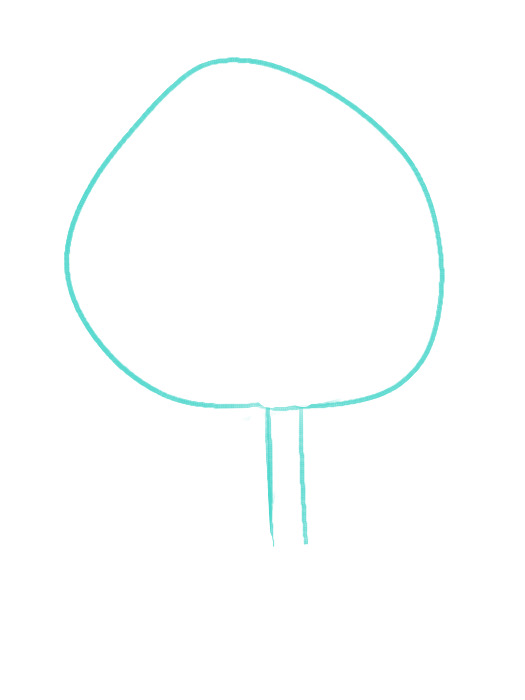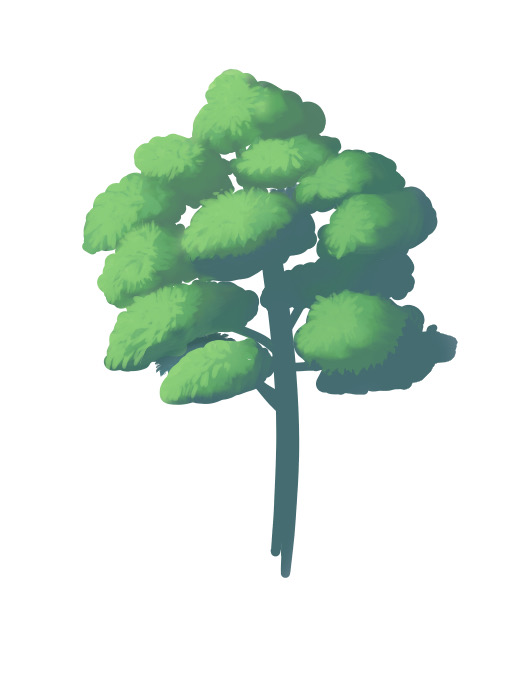How To Draw A Easy Cherry Blossom Tree
Whether information technology's beautiful cherry blossoms, fresh dark-green trees, or autumn leaves turning carmine and yellow, trees add seasonality and flair to your illustrations.
A background with a tree can be expressed by using tones and materials, just it is difficult to find a tree that matches your epitome.
And so, here are some basic tips on how to draw a tree and so you can go the tree you lot envisioned.
ane. Draw the positioning of the leaves and trunk
The first step is to depict the position of the tree and the size of the tree in which part of the tree will be drawn.
The tree can be roughly divided into two parts, the leaf part and the trunk part, and so I describe the positioning of these two parts start.

2. Draw the positioning of the leaf parts
When drawing a tree, the leaves are oftentimes the virtually confusing part of the tree.
As you lot can run into in the photo of a tree with few leaves, the leaves are fastened to each co-operative in a clump.
When you lot draw the leaves, you should think of this clump as 1 part of the tree and describe it as you go, so information technology'southward easier to create a three-dimensional outcome.
In one case you lot take fatigued the position of the leaves and trunk, you can draw the position of each office roughly by referring to a photograph.
At this bespeak, I draw a unproblematic circumvolve to locate the parts without worrying virtually the shape of the leaves.

three. Draw the base
When the positioning is completed, create a new layer and draw the base of operations in one color.
Choose a color for the darkest shadow prototype and draw the silhouette of the tree.

The sunlit areas appear xanthous and the shadows announced bluish.
Therefore, I have chosen a strong blue colour for the shadows.
The underlying color can be adapted to some extent by using filters subsequently, so don't worry besides much about the color.
four. Add colour to the base
Once y'all've painted the primer, create a new layer on elevation of the underlying layer and printing the clipping button.
By doing this, yous tin can color simply the underlying area, so permit's roughly light and darken the underlying layer.

Here is an image of the calorie-free hitting me from the top left corner, making the yellow-green to blue colour increasingly more intense from the light to the night.
(I'k using an airbrush.)
5. Painting the lightest part of the leaf
In one case the base of operations is drawn, create a new layer and draw the brighter parts of the leaves by clipping them.

What I'm using hither is not a pen brush with a articulate outline, only an acrylic castor that can be blurred past adjusting the brush pressure.
Since the area is exposed to the sun, I will paint it with a slightly yellowish green color.
Once again, don't worry too much about the shape of the leaves, but paint a firmer shape.
6. Connect the base of operations and the light areas
The colors of the calorie-free areas and the darker areas underneath appear to be floating away from each other, so we'll add an intermediate color to alloy them in.
Create a new layer underneath the light surface area layer and apply the neutral color by clipping.

vii. Smooth a soft light
In one case the light areas and the base are blended in, now create a layer at the superlative and airbrush a soft calorie-free to bring out more light.

eight. Painting the texture of leaves
I used a watercolour brush to add the mesomorphic silhouette of the leaves to each role of the paradigm, equally it looks smooth as it is.

9. Outline the leaves
After drawing the silhouette of the leaves on the part, it'south time to profile the entire epitome.
Trim the base layer and add leaves to make the silhouette await more like that.

Here, the underlying layer is scraped off with a pen castor (transparent colour).
[How to choose a transparent color]
Next to the color selection window square, in that location is a plaid foursquare.
You can select a transparent colour by pressing on this surface area.

10. Adding Shadows
Once the shape is in place, add together a few more darker shadows to give it a crisp, three-dimensional expect.
Create a new layer at the top and clipping, then utilise the airbrush to draw shadows on the leaves and other objects in the dorsum of the image.

You can larn more about finishing the tree, including highlights from the body area later on this, in the article How to Draw a Tree (ii), which you lot can also refer to here.
Source: https://medibangpaint.com/en/use/2020/07/how-to-draw-tree-1/
Posted by: schroederfrossuche.blogspot.com


0 Response to "How To Draw A Easy Cherry Blossom Tree"
Post a Comment